Triazole-imidazo[1,2-b]pyrazoles Able to Counteract Melanoma Cell Survival Without Compromising the Viability of Healthy Keratinocytes
Abstract
1. Introduction
2. Results
2.1. Chemistry
2.2. Biological Results
2.2.1. Anti-Proliferative Activity
2.2.2. 1h Affects the Viability of MeOV and MeTA Cell Lines
2.2.3. 1h Stimulates the Production of Reactive Oxygen Species (ROS) in MeOV and MeTA Cell Lines
2.2.4. 1h Is Not Cytotoxic for Healthy HaCAT Keratinocytes and Does Not Stimulate H2O2 Production in These Cells
2.3. In Silico Prediction of ADMET Properties of 1h
2.4. Micellar Solubilization of 1h
3. Discussion
4. Materials and Methods
4.1. General Information
4.2. Chemistry
4.2.1. General Procedure for Synthesis of Intermediates 3a–g
4.2.2. General Procedure for Synthesis of Intermediates 4a–g
4.2.3. Synthesis of Compounds 1a,b,d
4.2.4. Synthesis of Compounds 1c,e–g
4.2.5. Synthesis of 5-(2-Phenyl-2,3-dihydro-1H-imidazo[1,2-b]pyrazol-7-yl)-4-(4-(trifluoromethyl)phenyl)-4H-1,2,4-triazole-3-ol 1h
4.3. Biological Evaluation
4.3.1. NCI Anti-Proliferative Screening
4.3.2. Cell Culture Conditions
4.3.3. Treatments
4.3.4. Cell Viability Assay
4.3.5. Detection of Hydrogen Peroxide (H2O2) Production
4.3.6. Statistical Analysis
4.4. In Silico Prediction of ADMET Properties
4.5. Preparation of Micellar Solutions
5. Conclusions
Supplementary Materials
Author Contributions
Funding
Institutional Review Board Statement
Informed Consent Statement
Data Availability Statement
Acknowledgments
Conflicts of Interest
References
- Ulloora, S.; Shabaraya, R.; Adhikari, A.V. New 6-bromoimidazo [1,2-a]pyridine-2-carbohydrazide derivatives: Synthesis and anticonvulsant studies. Med. Chem. Res. 2014, 23, 3019–3028. [Google Scholar] [CrossRef]
- Zhu, H.; Zhang, Y.; Zhang, F.; Yang, Y.; Wang, X. Preparation of Triazole Derivatives as Fungicides. Chinese Patent CN103373987, 30 October 2013. [Google Scholar]
- Xinghai, L.; Zhai, Z.; Zhao, W.; Sun, Z.; Tan, C.; Weng, J.; Liu, X. Preparation of Triazoles as Agrochemical Herbicides. Chinese patent CN106220610, 14 December 2016. [Google Scholar]
- Al-Wahaibi, L.H.; Rabea, S.M.; Mahmoud, M.A.; Youssif, B.G.M.; Bräse, S.; Abdel-Aziz, S.A. Synthesis and Antimicrobial Evaluation of New 1,2,4-Triazolo[1,5-a]pyrimidine-Based Derivatives as Dual Inhibitors of Bacterial DNA Gyrase and DHFR. ACS Omega 2024, 9, 47261–47273. [Google Scholar] [CrossRef]
- Azam, J.; Noman, M.; Nadeem, H.; Ahmad, N.; Ul-Haq, Z.; Hilal, F.; Irshad, N. Pharmacological investigation of selected 1,2,4 triazole derivative against ethanol induced gastric ulcer. Bioorganic Chem. 2024, 154, 108040. [Google Scholar] [CrossRef]
- Zhang, J.; Lin, F.; Xiao, Y.; Cen, S.Y.; Wan, B.W.; Li, X.; Zhao, Y.; He, Y.; Yuan, H.X.; Nie, S. Discovery and optimization of 1,2,4-triazole derivatives as novel ferroptosis inhibitors. Europ. J. Med. Chem. 2024, 284, 117192. [Google Scholar] [CrossRef]
- Finlay, H.J.; Jiang, J.; Caringal, Y.; Kover, A.; Conder, M.L.; Xing, D.; Levesque, P.; Harper, T.; Hsueh, M.M.; Atwal, K.; et al. Triazolo and imidazo dihydropyrazolopyrimidine potassium channel antagonists. Bioorg. Med. Chem. Lett. 2013, 23, 1743–1747. [Google Scholar] [CrossRef]
- Song, J.; Pham, P.; Ma, J.; Novack, A.R.; Nashashibi, I.; Wone, D.W.G.; Shi, D.F.; Chen, X. Preparation of Bicyclic Agonists of GPR131 and Uses Thereof. WO2013032939, 7 March 2013. [Google Scholar]
- Andersen, H.S.; Kampen, G.C.T.; Christensen, I.T.; Mogensen, J.P.; Larsen, A.R. Pharmaceutical Use of Substituted 1,2,4-Triazoles for Modulating the Activity of 11β-Hydroxy Steroid Dehydrogenase Type 1 (11βHSD1). WO2004089367, 21 October 2004. [Google Scholar]
- Micheli, F.; Bernardelli, A.; Bianchi, F.; Braggio, S.; Castelletti, L.; Cavallini, P.; Cavanni, P.; Cremonesi, S.; Dal Cin, M.; Feriani, A.; et al. 1,2,4-Triazolyl octahydropyrrolo[2,3-b]pyrroles: A new series of potent and selective dopamine D3 receptor antagonists. Bioorg. Med. Chem. 2016, 24, 1619–1636. [Google Scholar] [CrossRef]
- Micheli, F.; Bacchi, A.; Braggio, S.; Castelletti, L.; Cavallini, P.; Cavanni, P.; Cremonesi, S.; Dal Cin, M.; Feriani, A.; Gehanne, S.; et al. 1,2,4-Triazolyl 5-Azaspiro[2.4]heptanes: Lead Identification and Early Lead Optimization of a New Series of Potent and Selective Dopamine D3 Receptor Antagonists. J. Med. Chem. 2016, 59, 8549–8576. [Google Scholar] [CrossRef]
- Arista, L.; Bonanomi, G.; Capelli, A.M.; Damiani, F.; Di Fabio, R.; Gentile, G.; Hamprecht, D.; Micheli, F.; Tarsi, L.; Tedesco, G.; et al. Preparation of N-(4H-1,2,4-Triazol-3-ylthioalkyl)-3-azabicyclo[3.1.0]hexane Derivatives Useful as Modulators of Dopamine D3 Receptors. WO2005080382, 1 September 2005. [Google Scholar]
- Kaya-Sezginer, E.; Oz Bedir, B.E.; Terzi, E.; Ozdemir Sanci, T.; Maryam, Z.; Acar Çevik, U. Design, Synthesis, and Biological Evaluation of New Benzimidazole-1,2,4-Triazole Derivatives as Potential Anticancer Agents. Chem. Biol. Drug Des. 2024, 104, e70033. [Google Scholar] [CrossRef]
- Mahmoud, E.; Ab-delhamid, D.; Youssif, B.G.M.; Gomaa, H.A.M.; Hayallah, A.M.; Abdel-Aziz, M. Design, synthesis, and antiproliferative activity of new indole/1,2,4-triazole/chalcone hybrids as EGFR and/or c-MET inhibitors. Arch. Pharm. 2024, 357, e2300562. [Google Scholar] [CrossRef]
- Deb, M.; Singh, H.; Manhas, D.; Nandi, U.; Guru, S.K.; Das, P. Development of di-arylated 1,2,4-triazole-based derivatives as therapeutic agents against breast cancer: Synthesis and biological evaluation. RSC Med. Chem. 2024, 15, 3097–3113. [Google Scholar] [CrossRef]
- Zhu, H.; Man, R.; Li, Z. Preparation of 3-[5-(benzylthio)-4-phenyl-4H-1,2,4-triazol-3-yl]-1-methyl-1H-indole Derivatives Useful as Anticancer Agents. Chinese Patent CN107082774, 22 August 2017. [Google Scholar]
- Mikhina, E.A.; Stepanycheva, D.V.; Maksimova, V.P.; Sineva, O.N.; Markelova, N.N.; Grebenkina, L.E.; Lesovaya, E.A.; Yakubovskaya, M.G.; Matveev, A.V.; Zhidkova, E.M. Synthesis of Alkyl/Aryloxymethyl Derivatives of 1,2,4-Triazole-3-Carboxamides and Their Biological Activities. Molecules 2024, 29, 4808. [Google Scholar] [CrossRef]
- Crider, A.M.; Hospital, A.; Sandoval, K.E.; Neumann, W.L.; Kukielski, S.; Garic, L.; Ingold, K.; Dunahoo, M.; Srabony, K.N.; Frare, R.; et al. 3-Thio-3,4,5-trisubstituted-1,2,4-triazoles: High affinity somatostatin receptor-4 agonist synthesis and structure-activity relationships. RSC Med. Chem. 2025, 16, 945–960. [Google Scholar] [CrossRef]
- Signorello, M.G.; Rapetti, F.; Meta, E.; Sidibè, A.; Bruno, O.; Brullo, C. New Series of Pyrazoles and Imidazo-pyrazoles Targeting Different Cancer and Inflammation Pathways. Molecules 2021, 26, 5735. [Google Scholar] [CrossRef]
- Brullo, C.; Rapetti, F.; Alfei, S.; Maric, I.; Rizzelli, F.; Mapelli, M.; Rosano, C.; Viale, M.; Bruno, O. Discovery of new antiproliferative imidazopyrazole acylhydrazone able to interact with microtubule system. ChemMedChem 2020, 15, 961–969. [Google Scholar] [CrossRef]
- Alfei, S.; Milanese, M.; Brullo, C.; Valenti, G.E.; Domenicotti, C.; Russo, E.; Marengo, B. Antiproliferative Imidazo-Pyrazole-Based Hydrogel: A Promising Approach for the Development of New Treatments for PLX-Resistant Melanoma. Pharmaceutics 2023, 15, 2425. [Google Scholar] [CrossRef]
- Spallarossa, A.; Rapetti, F.; Signorello, M.G.; Rosano, C.; Iervasi, E.; Ponassi, M.; Brullo, C. Insights into the Pharmacological Activity of the Imidazo-Pyrazole Scaffold. ChemMedChem 2023, 18, e202300252. [Google Scholar] [CrossRef]
- Iervasi, E.; Coronel Vargas, G.; Bachetti, T.; Tkachenko, K.; Spallarossa, A.; Brullo, C.; Rosano, C.; Carta, S.; Barboro, P.; Profumo, A.; et al. A Proteomics Approach Identifies RREB1 as a Crucial Molecular Target of Imidazo-Pyrazole Treatment in SKMEL-28 Melanoma Cells. Int. J. Mol. Sci. 2024, 25, 6760. [Google Scholar] [CrossRef]
- Available online: http://dtp.cancer.gov (accessed on 30 April 2025).
- Sies, H.; Belousov, V.V.; Chandel, N.S.; Davies, M.J.; Jones, D.P.; Mann, G.E.; Murphy, M.P.; Yamamoto, M.; Winterbourn, C. Defining roles of specific reactive oxygen species (ROS) in cell biology and physiology. Nat. Rev. Mol. Cell Biol. 2022, 23, 499–515. [Google Scholar] [CrossRef]
- Smolyarova, D.D.; Podgorny, O.V.; Bilan, D.S.; Belousov, V.V. A guide to genetically encoded tools for the study of H2O2. FEBS J. 2022, 289, 5382–5395. [Google Scholar] [CrossRef]
- Dulsat, J.; López-Nieto, B.; Estrada-Tejedor, R.; Borrell, J.I. Evaluation of Free Online ADMET Tools for Academic or Small Biotech Environments. Molecules 2023, 28, 776. [Google Scholar] [CrossRef]
- Parodi, A.; Righetti, G.; Pesce, E.; Salis, A.; Tasso, B.; Urbinati, C.; Tomati, V.; Damonte, G.; Rusnati, M.; Pedemonte, N.; et al. Discovery of novel VX-809 hybrid derivatives as F508del-CFTR correctors by molecular modeling, chemical synthesis and biological assays. Eur. J. Med. Chem. 2020, 208, 112833. [Google Scholar] [CrossRef]
- Abbotto, E.; Casini, B.; Piacente, F.; Scarano, N.; Cerri, E.; Tonelli, M.; Astigiano, C.; Millo, E.; Sturla, L.; Bruzzone, S.; et al. Novel Thiazole-Based SIRT2 Inhibitors Discovered via Molecular Modelling Studies and Enzymatic Assays. Pharmaceuticals 2023, 16, 1316. [Google Scholar] [CrossRef]
- ACD/Percepta Platform; Advanced Chemistry Development, Inc.: Toronto, ON, Canada, 2015.
- Veber, D.F.; Johnson, S.R.; Cheng, H.Y.; Smith, B.R.; Ward, K.W.; Kopple, K.D. Molecular properties that influence the oral bioavailability of drug candidates. J. Med. Chem. 2002, 45, 2615–2623. [Google Scholar] [CrossRef]
- Lipinski, C.A.; Lombardo, F.; Dominy, B.W.; Feeney, P.J. Experimental and computational approaches to estimate solubility and permeability in drug discovery and development settings. Adv. Drug Deliv. Rev. 2001, 46, 3–26. [Google Scholar] [CrossRef]
- Daina, A.; Michielin, O.; Zoete, V. SwissADME: A free web tool to evaluate pharmacokinetics, drug-likeness and medicinal chemistry friendliness of small molecules. Sci. Rep. 2017, 7, 42717. [Google Scholar] [CrossRef]
- Delaney, J.S. ESOL: Estimating Aqueous Solubility Directly from Molecular Structure. J. Chem. Inf. Model. 2004, 44, 1000–1005. [Google Scholar] [CrossRef]
- Noor, S.; Taj, M.B. Mixed-micellar approach for enhanced dye entrapment: A spectroscopic study. J. Mol. Liq. 2021, 338, 116701. [Google Scholar] [CrossRef]
- Parodi, B.; Russo, E.; Caviglioli, G.; Baldassari, S.; Gaglianone, N.; Schito, A.M.; Cafaggi, S. A chitosan lactate/poloxamer 407-based matrix containing Eudragit RS microparticles for vaginal delivery of econazole: Design and in vitro evaluation. Drug Dev. Ind. Pharm. 2013, 39, 1911–1920. [Google Scholar] [CrossRef]
- Russo, E.; Spallarossa, A.; Tasso, B.; Villa, C.; Brullo, C. Nanotechnology for Pediatric Retinoblastoma Therapy. Pharmaceuticals 2022, 15, 1087. [Google Scholar] [CrossRef]
- Shakeel, F.; Alshehri, S.; Ibrahim, M.A.; Altamimi, M.; Haq, N.; Elzayat, E.M.; Shazly, G.A. Solubilization and thermodynamic properties of simvastatin in various micellar solutions of different non-ionic surfactants: Computational modeling and solubilization capacity. PLoS ONE 2021, 16, e0249485. [Google Scholar] [CrossRef]
- Rana, A.A.; Yusaf, A.; Shahid, S.; Usman, M.; Ahmad, M.; Aslam, S.; Al-Hussain, S.A.; Zaki, M.E.A. Unveiling the Role of Nonionic Surfactants in Enhancing Cefotaxime Drug Solubility: A UV-Visible Spectroscopic Investigation in Single and Mixed Micellar Formulations. Pharmaceuticals 2023, 16, 1663. [Google Scholar] [CrossRef]
- Mahmood, M.E.; Al-Koofee, D.A. Effect of temperature changes on critical micelle concentration for tween series surfactant. Glob. J. Sci. Front. Res. Chem. 2013, 13, 1–7. [Google Scholar]
- Hanif, S.; Usman, M.; Hussain, A.; Rasool, N.; Zubair, M.; Rana, U.A. Solubilization of Benzothiazole (BNZ) by micellar media of Sodium dodecyl sulphate and Cetyl trimethylammonium bromide. J. Mol. Liq. 2015, 211, 7–14. [Google Scholar] [CrossRef]
- Meta, E.; Brullo, C.; Sidibe, A.; Imhof, B.A.; Bruno, O. Design, synthesis and biological evaluation of new pyrazolyl-ureas and imidazopyrazolecarboxamides able to interfere with MAPK and PI3K upstream signaling involved in the angiogenesis. Eur. J. Med. Chem. 2017, 133, 24–35. [Google Scholar] [CrossRef]
- Colla, R.; Izzotti, A.; De Ciucis, C.; Fenoglio, D.; Ravera, S.; Speciale, A.; Ricciarelli, R.; Furfaro, A.L.; Pulliero, A.; Passalacqua, M.; et al. Glutathione-Mediated Antioxidant Response and Aerobic Metabolism: Two Crucial Factors Involved in Determining the Multi-Drug Resistance of High-Risk Neuroblastoma. Oncotarget 2016, 7, 70715–70737. [Google Scholar] [CrossRef]
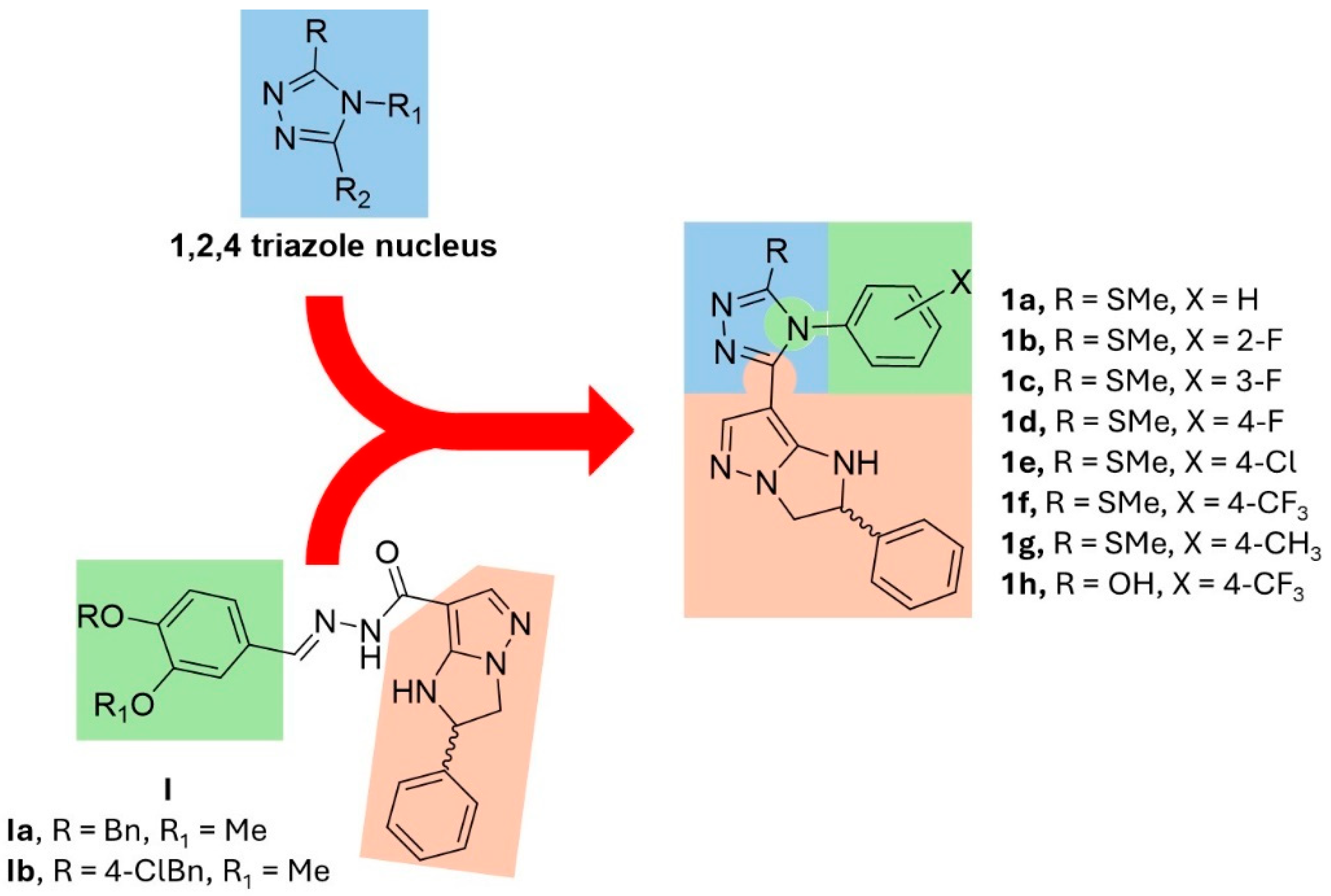
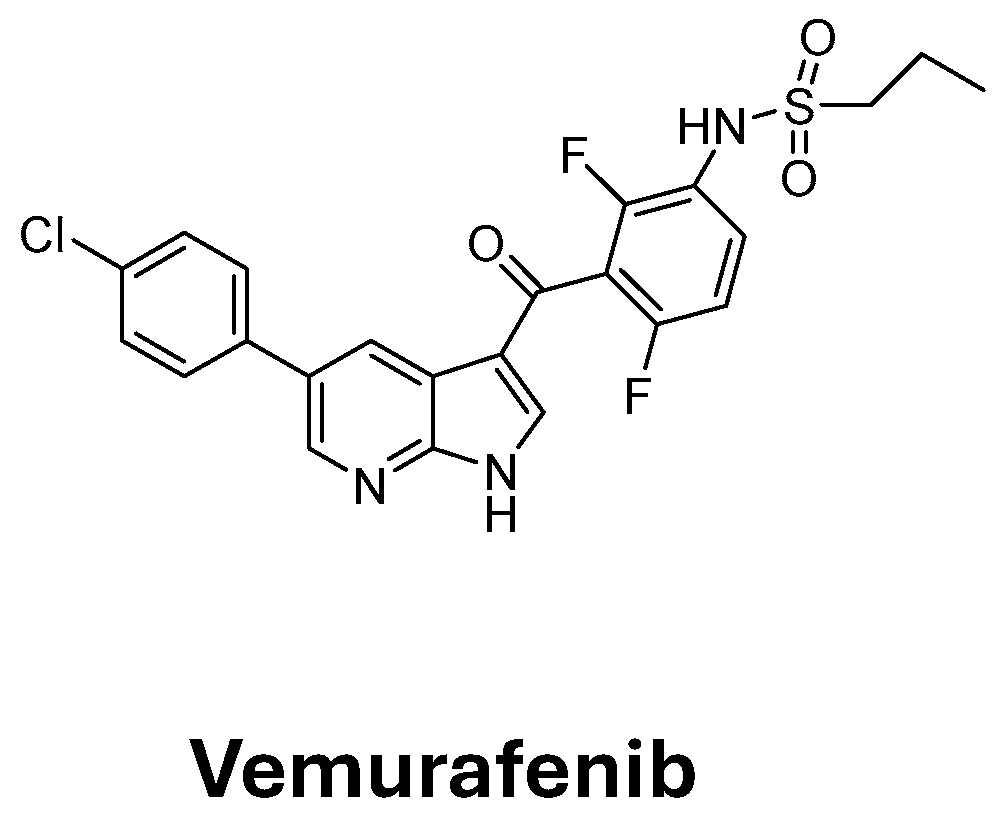
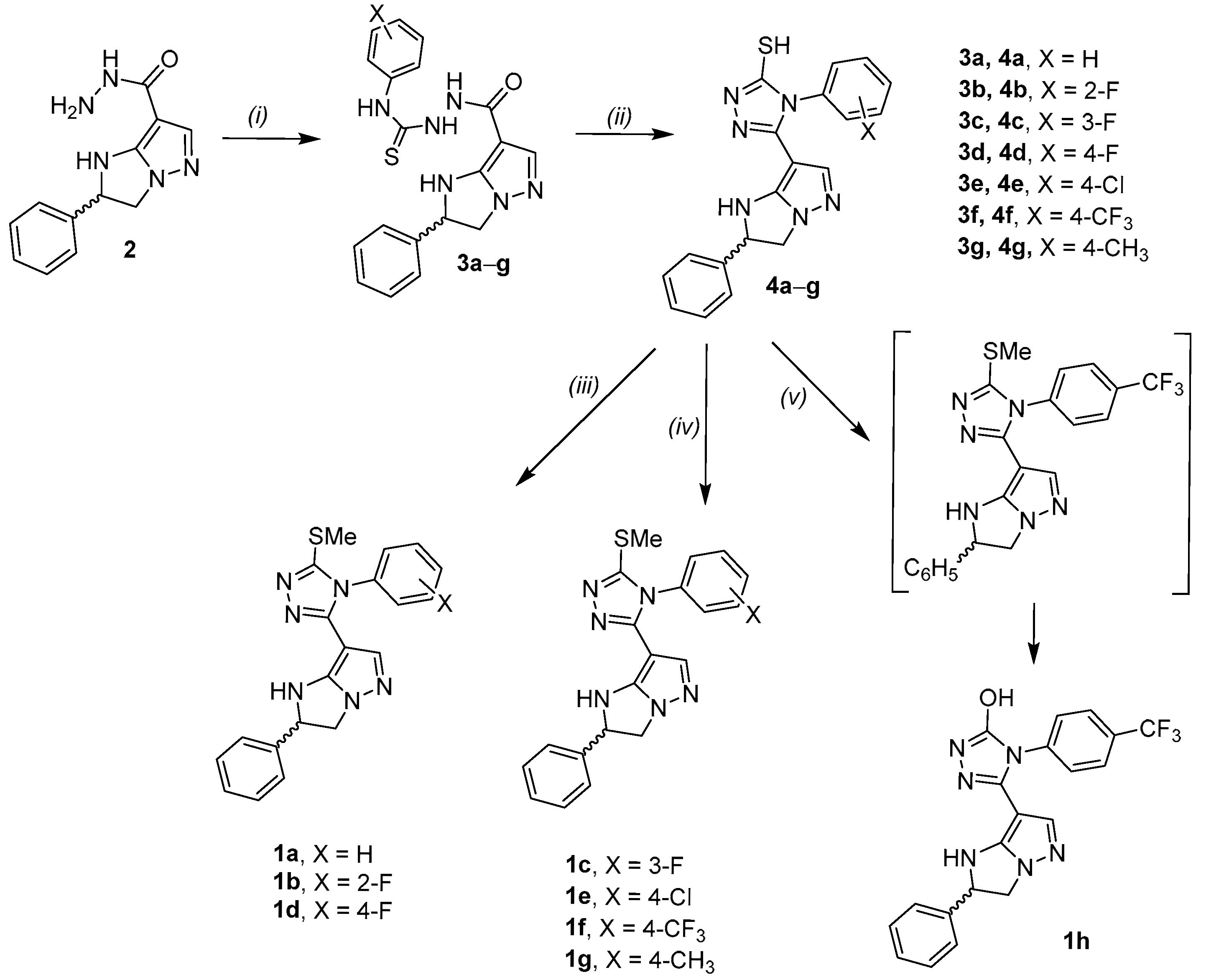
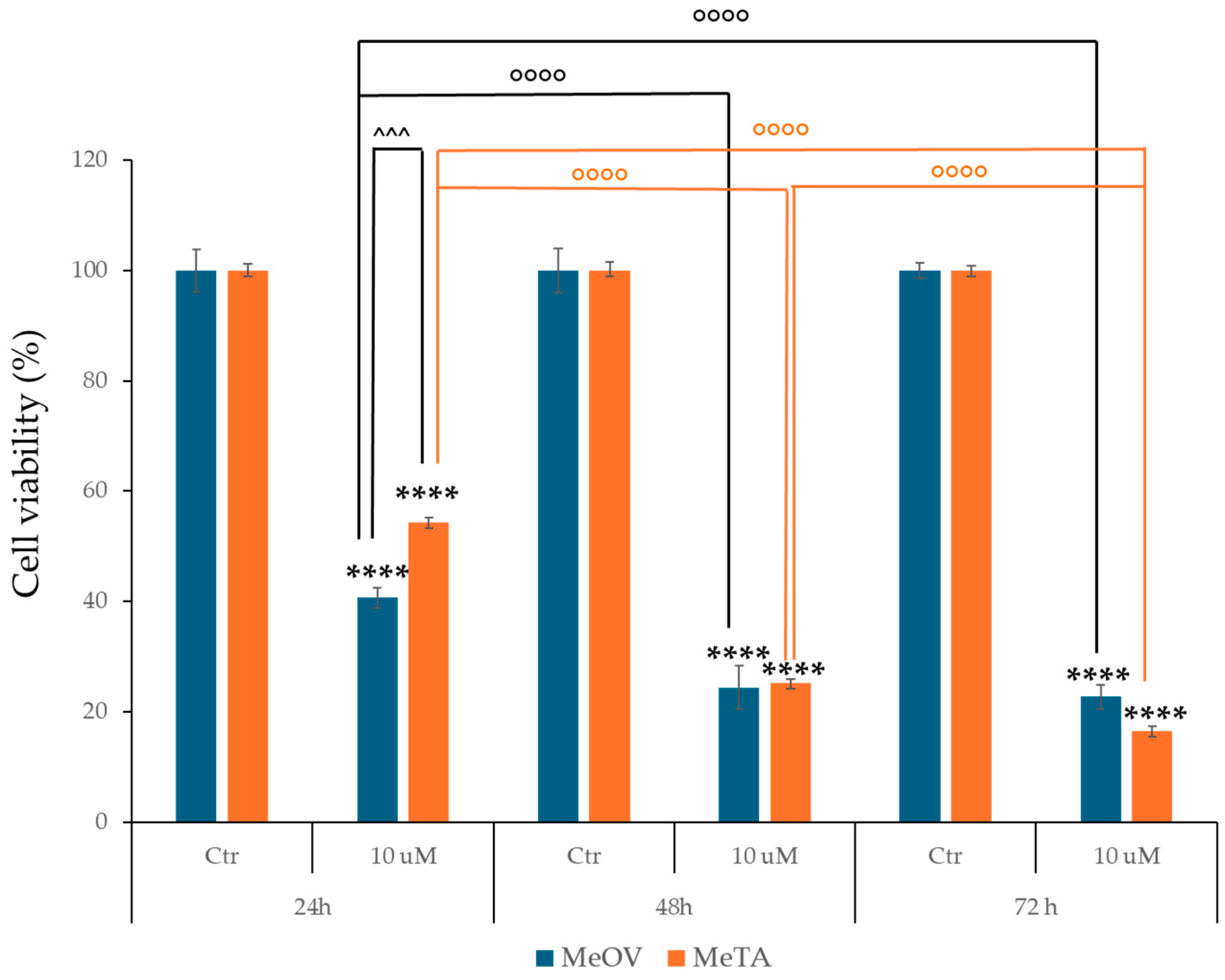
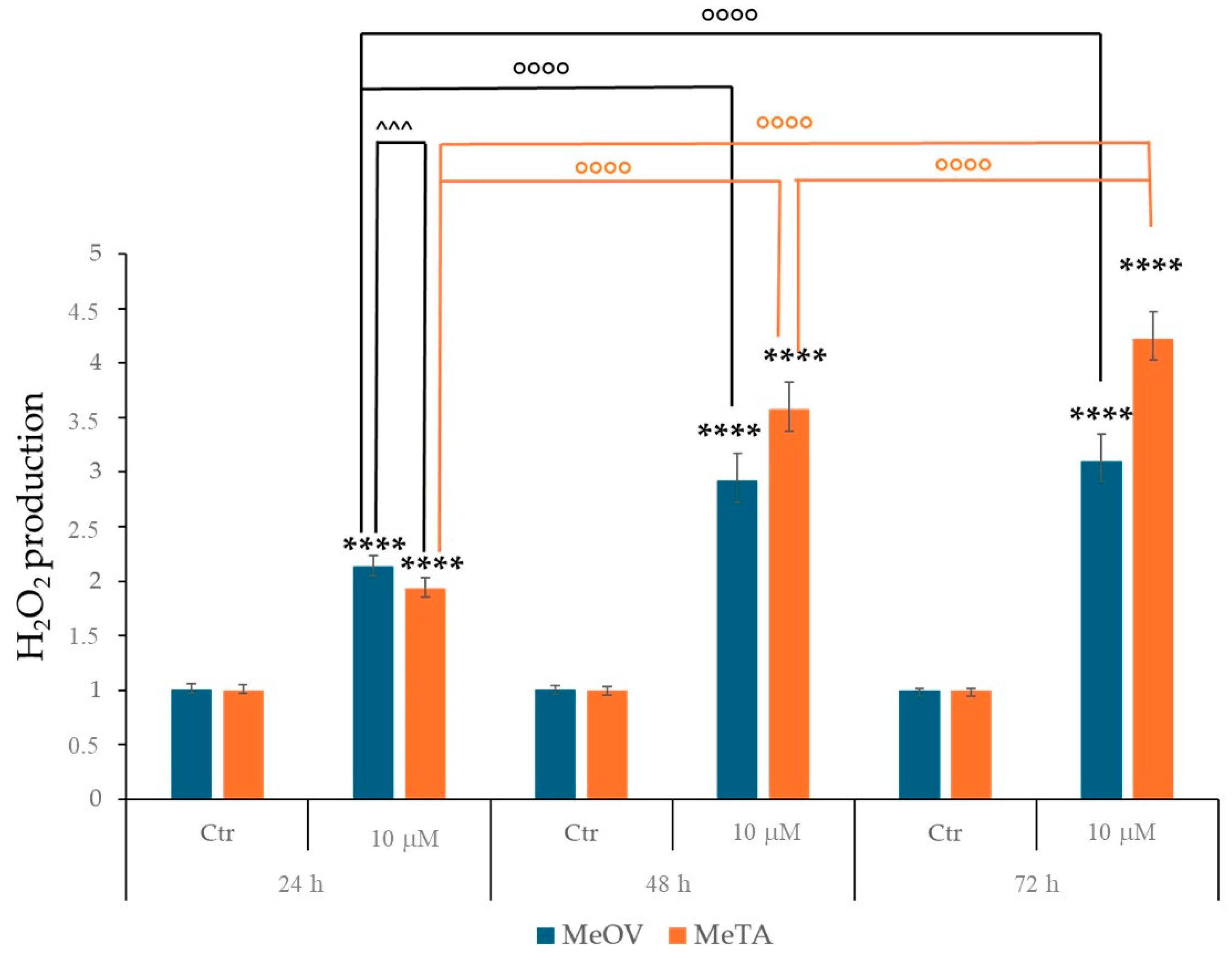

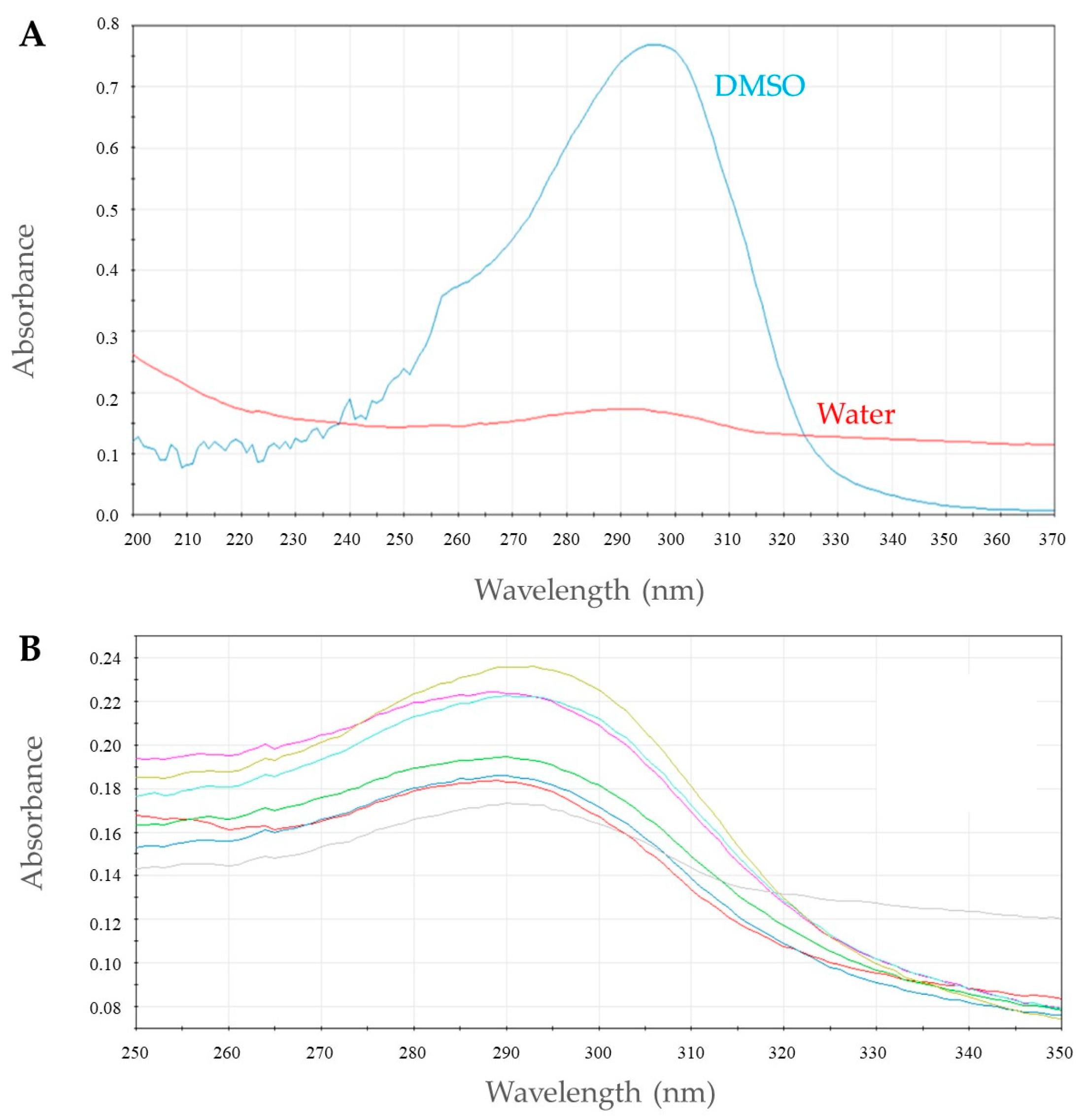
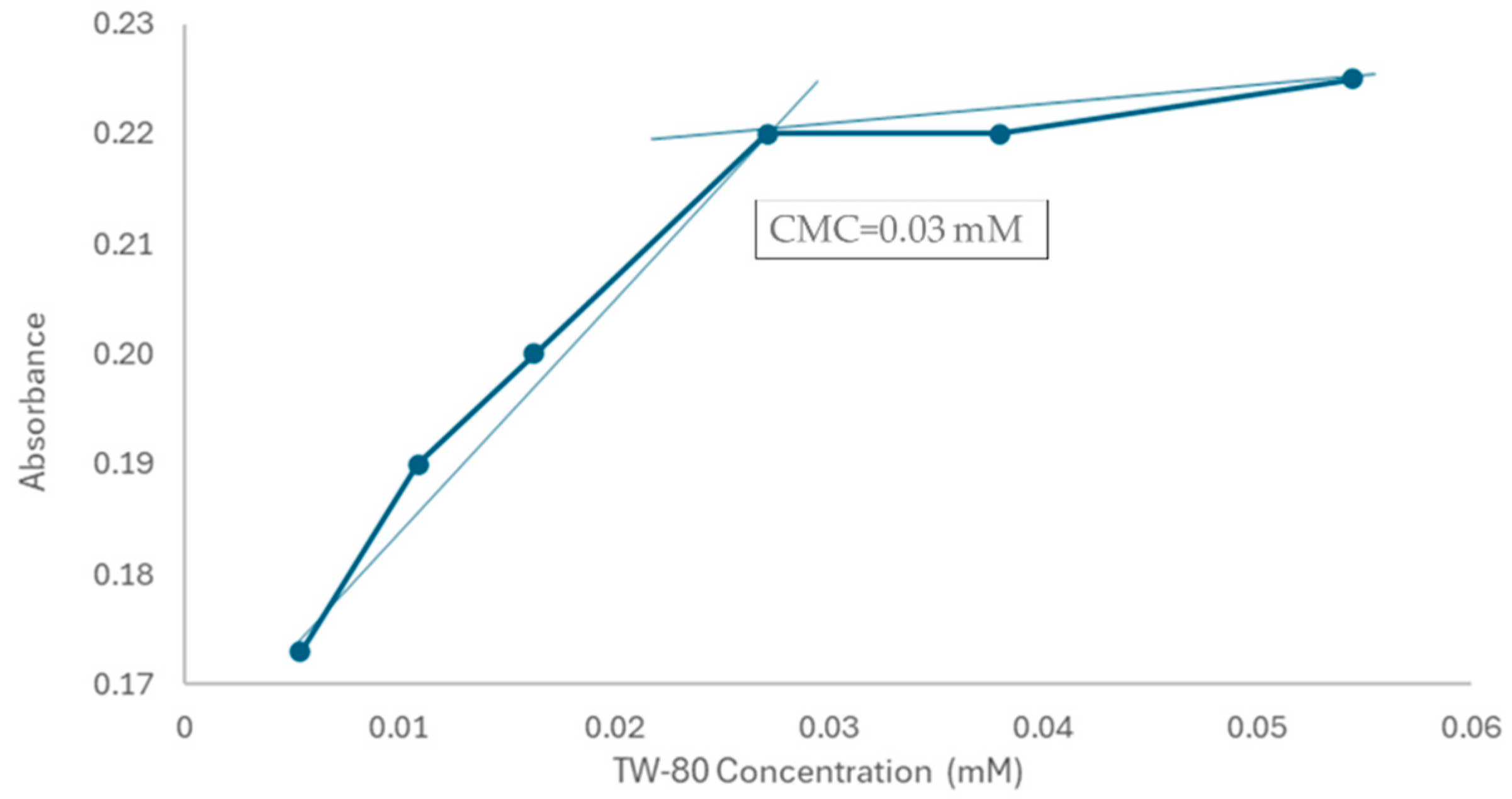
| Growth Percent (%) | |||
|---|---|---|---|
| Tumor/Cell Line | 1a | 1e | 1h |
| Leukaemia | |||
| K-562 | >60 | >60 | 3.03 |
| CCFR-CEM | 18.23 | >60 | 47.96 |
| MOLT-4 | >60 | >60 | 41.87 |
| RPMI-8226 | >60 | >60 | 56.88 |
| SR | >60 | >60 | 17.22 |
| Non-small-cell lung cancer | |||
| A549/ATCC | >60 | >60 | 45.49 |
| EKVX | >60 | >60 | 55.99 |
| NCI-H522 | 55.05 | >60 | 26.08 |
| Colon Cancer | |||
| HCT-116 | >60 | >60 | 46.00 |
| HCT-15 | >60 | >60 | 35.08 |
| HT29 | >60 | >60 | 28.39 |
| KM12 | >60 | >60 | 49.25 |
| SW-620 | >60 | >60 | 50.88 |
| CNS cancer | |||
| SF-295 | >60 | >60 | 32.01 |
| U251 | >60 | >60 | 58.04 |
| Melanoma | |||
| MDA-MB-435 * | >60 | >60 | −25.66 |
| SKMEL-2 | >60 | >60 | 50.21 |
| SKMEL-5 | >60 | >60 | 31.31 |
| UACC-257 | >60 | >60 | 51.37 |
| UACC-62 | >60 | 63.33 | 40.27 |
| Ovarian cancer | |||
| OVCAR-3 | >60 | >60 | 37.58 |
| OVCAR-4 | >60 | >60 | 59.09 |
| NCI/ADR-RES | >60 | >60 | 56.01 |
| Renal cancer | |||
| A498 | >60 | 55.24 | 46.80 |
| ACHN | >60 | >60 | 52.27 |
| CAKI-1 | >60 | >60 | 32.04 |
| UO-31 | >60 | >60 | 53.70 |
| Prostate cancer | |||
| PC-3 | >60 | >60 | 46.28 |
| Breast cancer | |||
| MCF7 | >60 | >60 | 26.87 |
| T-47D | >60 | >60 | 54.23 |
Disclaimer/Publisher’s Note: The statements, opinions and data contained in all publications are solely those of the individual author(s) and contributor(s) and not of MDPI and/or the editor(s). MDPI and/or the editor(s) disclaim responsibility for any injury to people or property resulting from any ideas, methods, instructions or products referred to in the content. |
© 2025 by the authors. Licensee MDPI, Basel, Switzerland. This article is an open access article distributed under the terms and conditions of the Creative Commons Attribution (CC BY) license (https://creativecommons.org/licenses/by/4.0/).
Share and Cite
Brullo, C.; Marengo, B.; Domenicotti, C.; Lusardi, M.; Cichero, E.; Salis, A.; Caviglia, D.; Russo, E.; Spallarossa, A. Triazole-imidazo[1,2-b]pyrazoles Able to Counteract Melanoma Cell Survival Without Compromising the Viability of Healthy Keratinocytes. Int. J. Mol. Sci. 2025, 26, 6312. https://doi.org/10.3390/ijms26136312
Brullo C, Marengo B, Domenicotti C, Lusardi M, Cichero E, Salis A, Caviglia D, Russo E, Spallarossa A. Triazole-imidazo[1,2-b]pyrazoles Able to Counteract Melanoma Cell Survival Without Compromising the Viability of Healthy Keratinocytes. International Journal of Molecular Sciences. 2025; 26(13):6312. https://doi.org/10.3390/ijms26136312
Chicago/Turabian StyleBrullo, Chiara, Barbara Marengo, Cinzia Domenicotti, Matteo Lusardi, Elena Cichero, Annalisa Salis, Debora Caviglia, Eleonora Russo, and Andrea Spallarossa. 2025. "Triazole-imidazo[1,2-b]pyrazoles Able to Counteract Melanoma Cell Survival Without Compromising the Viability of Healthy Keratinocytes" International Journal of Molecular Sciences 26, no. 13: 6312. https://doi.org/10.3390/ijms26136312
APA StyleBrullo, C., Marengo, B., Domenicotti, C., Lusardi, M., Cichero, E., Salis, A., Caviglia, D., Russo, E., & Spallarossa, A. (2025). Triazole-imidazo[1,2-b]pyrazoles Able to Counteract Melanoma Cell Survival Without Compromising the Viability of Healthy Keratinocytes. International Journal of Molecular Sciences, 26(13), 6312. https://doi.org/10.3390/ijms26136312












